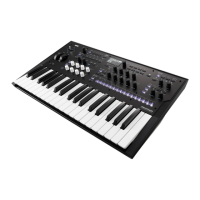Vector
31
When the Vector Envelope is in use, the Vector Joystick offsets the Vector Envelope position by up to halfway across
either axis. For instance, if the Envelope is all the way to the right of the X axis, and the Joystick is all the way to the left,
the actual Vector position will be in the center of the X axis.
Vector Volume Control and modulation
Vector does several things:
• It generates four per-voice modulation signals, Vector Env A/B/C/D
• It generates similar modulation signals at the Performance level, shared by all voices, for modulation of things like
effects and the Performance Mod Knobs
• When Vector Volume is On, it also controls the relative volumes of Layers A-D on a per-voice basis
You can also use the Vector Joystick’s X- and Y-axes as modulation sources, independent from the Vector Envelope.
Since the Vector Envelope’s settings are stored in the Performance, it’s best used for Performance-specific purposes,
such as changing parameters (e.g. filter cutoff) in conjunction with volume, or interactions between layers.
Vector and MIDI
The Vector Joystick sends and receives two MIDI controllers: CC #16 is the X axis, and CC #17 is the Y axis.
Vector Env Volume
The Vector Envelope has five points: 0, 1, 2, 3 (Loop), and Release. Each point has X and Y positions, from which the
A, B, C, and D percentages are derived.
This page shows the A/B/C/D volume values for each point as percentages of full volume. For a given point, A, B, C,
and D will always add up to 100; positions outside the diamond are clipped. To change the values, cursor to a point and
then move the Vector Joystick. (Note: this requires that the Vector Env Setup page’s Joystick Edit is On).
The Vector Env Volume and Vector Env X-Y pages show the same set of position values from different perspectives.
You can edit the values on either page.
Vector Env X-Y
This page shows the X-Y coordinates for each point, which also translate into the Vector Env modulation outputs. You
can edit these by hand if desired, or enter values into the selected point via the joystick. Unlike volumes, modulation
outputs are not clipped to the diamond shape.
Note: edits from the joystick apply to both X and Y values, even though only one of the pair will be selected.
Positions, times, and Time Scale are modulatable from channel sources such as the Mod Wheel, MIDI CCs, and
Performance Mod Knobs as well as by velocity and note number—but not from per-voice sources such as Envelopes
and LFOs.

